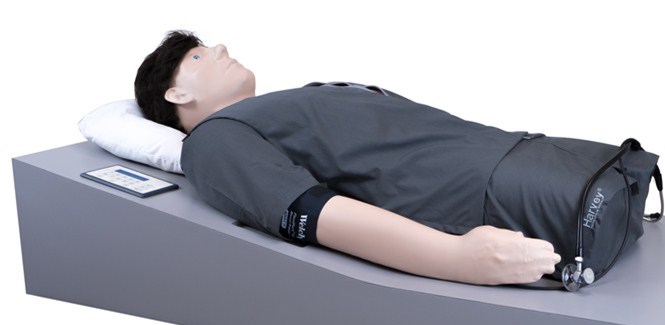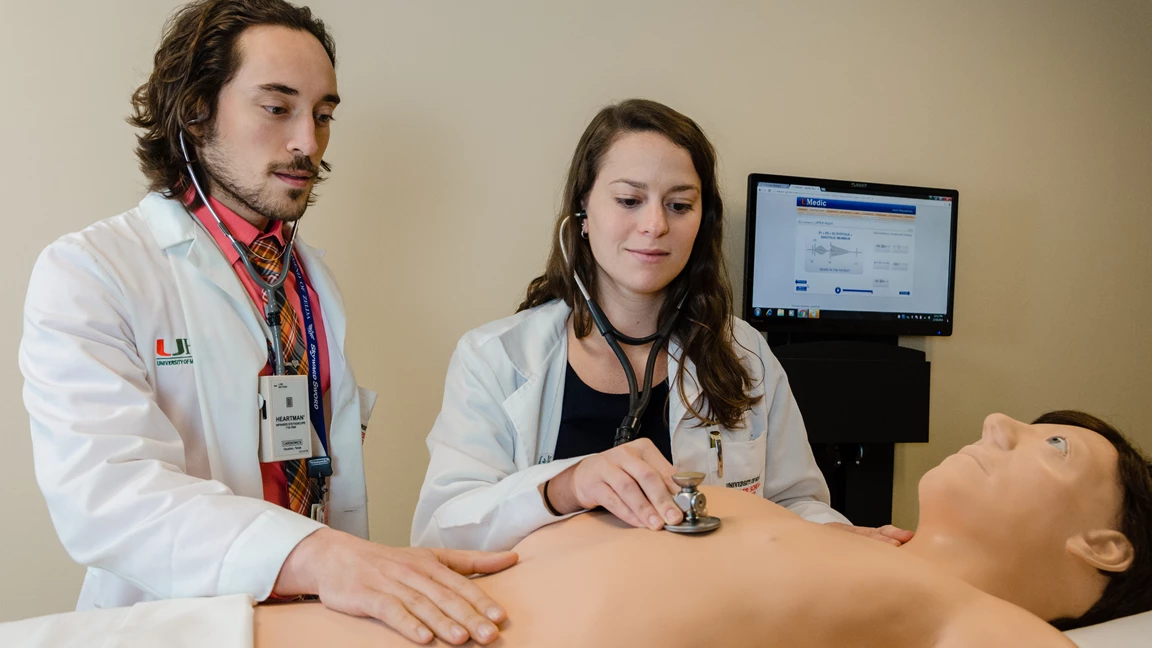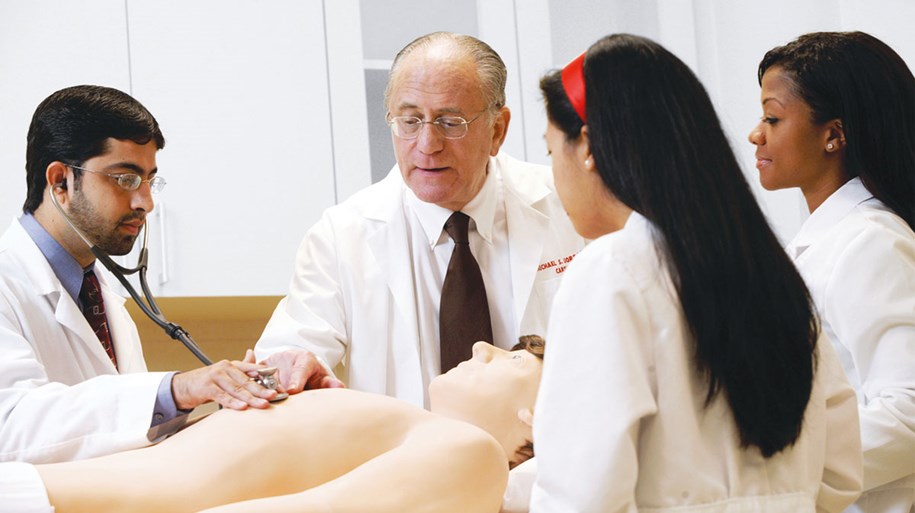
Harvey: Cardiopulmonary Training that Improves Patient Care
For nearly 50 years, Harvey has been a proven simulation system to teach bedside cardiac assessment skills that transfer to real patients. Join more than 50 countries worldwide using Harvey to train the next generation of healthcare providers. Help your students meet milestones and benchmarks to save lives.
What's new?
Next Generation Harvey® provides cardiopulmonary training for all healthcare providers. This full-size manikin realistically simulates nearly any cardiac disease at the touch of a button. New features include 20 additional patient scenarios – some with faster heart and respiratory rates – for a total of 50 conditions, 10 comprehensive standardized patient cases for teaching and assessment, and enhanced physical exam findings. Also new, additional bilateral arm pulses and laptop to support UMedic and future LLEAP integration.

Designed for any Learning Environment
Harvey is portable and may be used in any environment in which a patient may be examined. Small groups with stethophones may learn without an instructor by using the slide programs or the UMedic system. If the area is only for Harvey, it should be about the size of a patient’s small hospital room, so that space is available for “Bedside Rounds.”
Harvey may also be used in Clinical Skills or Simulation Training Centers or SP training areas. Larger groups may learn in a lecture hall by using stethophones for auscultation and video projection for observing other physical findings.
Most importantly, the main location should be convenient for both students and the person-in-charge. Even though Harvey functions as a self-learning device, the nearby presence and availability of knowledgeable faculty and staff will further ensure a successful program.
Specifications
- Cardiac Disease Cases (total 50)
- Standardized Patient Curriculum (total 10)
- Portable
- Breath Sound Areas (total 6)
- Cardiac Auscultation Areas (total 9)
- Digitally Driven Impulses (total 14)
- Bilateral jugular venous impulses (2)
- Bilateral carotid, brachial, radial and femoral arterial pulses (8)
- Chest wall/precordial impulses (pulmonary artery, right ventricle, left ventricle, and displaced left ventricle) (4)
- Modifiable Amplitudes and Intensities
- Speaker for History-taking
- Multiple Learning Environments include:
- Self-learning linked with UMedic
- Instructor in small group sessions
- Lecture settings
- Normal
- Innocent Murmur
- Hypertension
- Mild Mitral Regurgitation
- Mitral Valve Prolapse, Combined Click and Murmur
- Acute Pericarditis
- Mild Tricuspid Regurgitation
- Chronic Severe Aortic Regurgitation
- Cardiomyopathy
- Severe Aortic Stenosis Addition of 10 New Harvey cases at rate of 90 BPM
Addition of 10 New Cases
- Mild Systolic Heart Failure
- Mild Diastolic Heart Failure
- Mild Mitral Regurgitation (variant)
- Moderate Mitral Regurgitation
- Mild Aortic Regurgitation
- Coronary Disease with Heart Failure
- Moderate Aortic Stenosis
- Pulmonary Embolism
- Cor Pulmonale
- Aortic Stenosis and Regurgitation
Standardized Patient Library – 10 cases (Printed Notebook and DVD digital files)

Core Curriculum Features
Harvey provides a comprehensive curriculum by realistically simulating 50 conditions. It is structured to start with common, less complex conditions and progress to more rare and complex diseases.
- Introductory Program
- Normal (60 and 90 BPM)
- Innocent Murmur (60 and 90 BPM)
- Aortic Valve Sclerosis
- Hypertension (60 and 90 BPM)
- Angina Pectoris
- Acute Inferior Myocardial Infarction
- Acute Anterior Myocardial Infarction
- Ventricular Aneurysm
- Mitral Valve Prolapse (MVP) (60 and 90 BPM)
- MVP, Isolated Click and Murmur
- Mitral Regurgitation, chronic
- Mitral Regurgitation, mild (60 and 90 BPM)
- Mitral Regurgitation, mild (variant)
- Mitral Regurgitation, acute
- Mitral Stenosis (MS) with severe Tricuspid Regurgitation (TR)
- MS with mild TR (60 and 90 BPM)
- Mitral Stenosis & Regurgitation
- Aortic Regurgitation, chronic (60 and 90 BPM)
- Aortic Regurgitation, acute
- Aortic Stenosis (60 and 90 BPM)
- Hypertrophic Obstructive Cardiomyopathy
- Cardiomyopathy (60 and 90 BPM)
- Acute Pericarditis (60 and 90 BPM)
- Primary Pulmonary Hypertension
- Atrial Septal Defect
- Ventricular Septal Defect
- Patent Ductus Arteriosus
- Pulmonary Stenosis
- Coarctation of the Aorta
- Tetralogy of Fallot
- Coronary Disease with Heart Failure
- Mild Systolic Heart Failure
- Mild Diastolic Heart Failure
- Moderate Mitral Regurgitation
- Moderate Aortic Stenosis
- Mild Aortic Regurgitation
- Aortic Stenosis and Regurgitation
- Pulmonary Embolism
- Cor Pulmonale
Learning Enviroment
“Harvey” is portable and may be used in any environment in which a patient may be examined. Small groups with stethophones may learn without an instructor by using the slide programs or the UMedic system. If the area is only for “Harvey,” it should be about the size of a patient’s small hospital room, so that space is available for “Bedside Rounds.” “Harvey” may also be used in Clinical Skills or Simulation Training Centers or SP training areas. Larger groups may learn in a lecture hall by using stethophones for auscultation and video projection for observing other physical findings. Most important, the main location should be convenient for both students and the person-in-charge. Even though “Harvey” functions as a self-learning device, the nearby presence and availability of knowledgeable faculty and staff will further ensure a successful program.